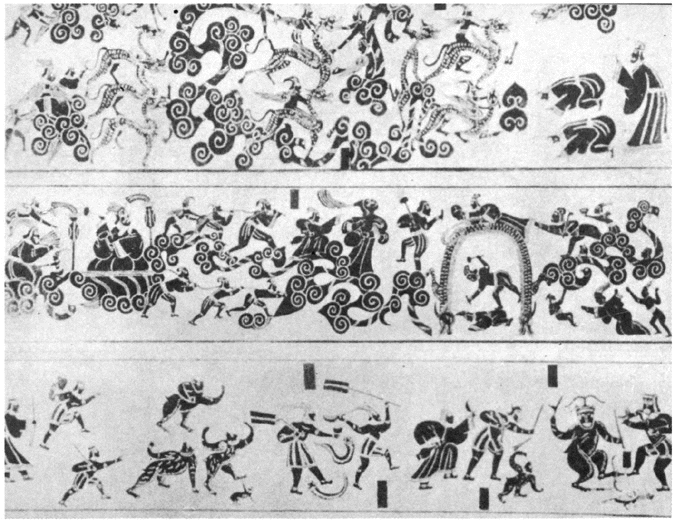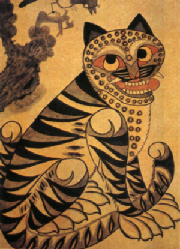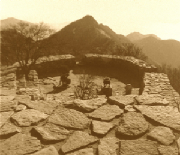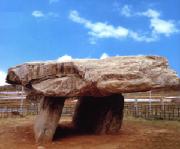|

The pattern Dan-Gun consists of 21 movements and is required for advancement from 8th geup (yellow belt) to 7th geup
(high yellow belt). General Choi Hong-Hi, Master of the International Taekwon-Do
Federation and Father of Taekwon-Do, states in his book, The Encyclopedia of Taekwon-Do, that the pattern Dan-Gun "is named
after the holy Dangun, the legendary founder of Korea in the year 2333 B.C."

|
| Mount Myohyang, Birthplace of the Holy Dangun |
The legend of Dangun was first recorded by the 12th century scholar-statesman-general Kim Pu-Sik in his historical
work Samguk Sagi, Annals of the Three Kingdoms. It is considered to be the earliest
and the most important surviving source of history on the three kingdoms of Korea. In
the face of continual threats of foreign domination the legend of Dangun was often instrumental in reviving national unity
after the 12th century. In 1909 it again increased in popularity in the form
of the Taejong-Gyo, or Great Dangun Teaching.
The legend of Dangun concerns
the earliest Korean people, believed to have come from present-day Manchuria, northern China, and Mongolia. These people eventually formed tribal leagues, which collectively became known as ancient Korea or Joseon,
literally meaning, "Land of the Morning Calm." They ruled the territory between
the Liao River in southern Manchuria and the Taedong River in central North Korea. Among
these people, the most powerful clan was the Bear Totem family, which provided most of the rules for this tribal league. This may have had some influence on the part of the bear in the Legend of Dangun.

|
| Chinese Mortuary Slabs Portraying the Legend of Dangun |
The legend is based on one
member of the Korean trinity consisting of Whanin (The Creator), Whanung (The Son of the Creator), and Dangun (the human form
of the creator). As legend goes, Whanung was given permission to start a mortal
Kingdom on Earth. In 2333 B.C. he descended to earth with 3,000 spirits to Teabeak
Mountain in what is now Pyongan Province. He gathered these spirits under the
pakdal (sandalwood) tree and declared himself the King of the Universe. Although
he governed this kingdom with the help of the "Wind General," the "Rain Governor," and the "Cloud Teacher," he realized that
someday he would need to be in a human form in order to reign over a human kingdom.
This need was fulfilled when one day Whanung overheard a bear and a tiger who said, "Would that we might become men." Whanung said to them, "Here are 20 pieces of garlic and a stick of artemisia (a type
of sagebrush) for each of you. Eat them and retire from the sunlight for 21 days
and you will become men." Both did as they were told and retreated into a cave. The tiger, because of his fierceness of nature, could not endure the entire 21 days
and came out. The bear, with greater patience and faith, stayed for the duration
and was transformed into a perfect woman. Her first wish was for motherhood,
and she cried out, "Give me a son!" At that moment, Whanung was passing
by on the wind and saw her sitting by a stream. He circled around her, breathed
on her, and she became pregnant. Her son was born on Mount Myohyang under the
baekdan tree and was named Dangun Wanggeom, Lord of the Baekdan Tree. Years later,
men of the "nine wild tribes," called the Ku-I, found him sitting under the baekdan tree and made him their king.

|
| Korean Painting of Tiger |
Dangun eventually led his people south from his first residence on Mt. Baekdu (see picture under Cheon-Ji) along
the Yalu River to Pyongyang and made it Korea's first capital. The
people of this time were primitive folk who were fond of dancing, drinking, and singing. They wore clothes made with grasses and ate fruits, berries, nuts, and roots. They lived beneath the trees during the summer and in holes in the ground in the winter. Into their simple life Dangun was said to have introduced the rite of marriage, the subject-king relationship,
the arts of cooking and house building, cutting of trees and agriculture, and how to bind up their hair with cloth. He also introduced religious worship and is said to have built the first altar on Kangwha Island in 2265 B.C. This altar sits today on top of the
island's highest peak, Munisan, and is known as Dangun's Altar. Dangun lived
with his wife, Pi So-Ap, and his sons, who are said to have built the fortress of Samnang at Chungdung
Island.

|
| Dangun's Alter at Munisan on Kangwha Island |
In 1122 B.C., the uncle of
the Shang King of China, Ki-Ja, escaped the overthrow of the Shang Dynasty and migrated to Korea with 5000 followers. According to the legend, after reigning for 1,211 years, Dangun fled from the Ki-Ja
forces to the town of Munwha, resumed his spirit form, and disappeared from the earth.
The shrine to the "Trinity" in Munwha today contains his 410-foot-circumference "grave." The Ki-Ja assumed the rule of Korea from 1122 B.C. to 193 B.C., teaching the people Chinese culture in
the form of letters, reading, writing, medicine, and art.

|
| Dolem at Pugunri on Kangwha Island |
Since the word "geom" means both King and Bear in old Korean languages,
it is not unnatural for this legend to have originated during the more primitive culture of Korea. Modern
Korea celebrates October 3rd as Dangun Day in memory of the holy founder of Korea, and the South Korean government has established
the year 2333 B.C. as the birth date of Korea.
|

